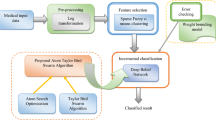Abstract
In the context of "smart healthcare", due to the substantial increase in medical data and patient diagnostic needs, conventional diagnostic methods are gradually unable to meet the current diagnostic requirements. Therefore, a network medical image information feature diagnosis method based on big data is designed to improve the effect of disease diagnosis. The convolutional deep belief network is used to extract the information features of the network medical image in the network medical image. The t-SNE algorithm is used to select the more valuable network medical image information features in the extracted features. Using stacking to integrate AdaBoost and Bagging algorithm, the disease diagnosis results are obtained. The artificial bee colony algorithm is used to optimize the weights of the multi-level ensemble learning algorithm to improve the accuracy of disease diagnosis. In the multi-level ensemble learning algorithm after weight optimization, the selected network medical image information features are input and the disease diagnosis results are output. Experiments show that this method can effectively extract the information features of network medical images and accurately diagnose diseases. At different spatial resolutions of network medical images, the Kappa values of disease diagnosis of this method are high, and the lowest Kappa value is about 0.875, which means that this method has high disease diagnosis performance.




Similar content being viewed by others
References
Li J, Meng Y, Ma L et al (2022) A federated learning based privacy-preserving smart healthcare system. IEEE Trans Industr Inf 18(3):2021–2031
Collins CJ, Yi F, Dayuha R et al (2021) Direct measurement of ATP7B peptides is highly effective in the diagnosis of Wilson disease. Gastroenterology 160(7):2367–2384
Pei X, Fan H, Tang Y (2021) Temporal pyramid attention-based spatiotemporal fusion model for parkinson’s disease diagnosis from gait data. IET Signal Proc 15(2):80–87
Kugunavar S, Prabhakar CJ (2021) Content-based medical image retrieval using delaunay triangulation segmentation technique. J Inf Technol Res 14(2):48–66
Wen C, Liu S, Liu S et al (2023) ACSN: Attention capsule sampling network for diagnosing COVID-19 based on chest CT scans. Comput Biol Med 153:106338
Tiwari A, Saha S, Bhattacharyya P (2022) A knowledge infused context driven dialogue agent for disease diagnosis using hierarchical reinforcement learning. Knowl-Based Syst 242:108292
Geisler EL, Agarwal S, Hallac RR et al (2021) A role for artificial intelligence in the classification of craniofacial anomalies. J Craniofacial Surg 32(3):967–969 (Publish Ahead of Print)
Lali R, Chong M, Omidi A et al (2021) Calibrated rare variant genetic risk scores for complex disease prediction using large exome sequence repositories. Nat Commun 12:5852
Nezu N, Usui Y, Saito A et al (2021) Machine learning approach for intraocular disease prediction based on aqueous humor immune mediator profiles. Ophthalmology 128(8):1197–1208
Sharma D, Xu W (2021) Longitudinal microbiome and machine learning: a cnn-lstm based neural network model for disease prediction. Genet Epidemiol 45(7):788–789
Tapas S, Péricles M, Galdino JV et al (2021) Grammar-based automatic programming for medical data classification: an experimental study. Artif Intell Rev 54(6):4097–4135
Thamsen B, Yevtushenko P, Gundelwein L et al (2021) Synthetic database of aortic morphometry and hemodynamics: overcoming medical imaging data availability. IEEE Trans Med Imaging 40(5):1438–1449
Liu S, Huang S, Wang S et al (2023) Visual tracking in complex scenes: a location fusion mechanism based on the combination of multiple visual cognition flows. Information Fusion 96:281–296
Liu X, Hou S, Liu S et al (2023) Attention-based multimodal glioma segmentation with multi-attention layers for small-intensity dissimilarity. J King Saud Univ - Comput Inf Sci 35:183–195
Siar M, Teshnehlab M (2022) A combination of feature extraction methods and deep learning for brain tumour classification. IET Image Proc 16(2):416–441
Beram SM, Pallathadka H, Patra I (2022) A machine learning based framework for pre-processing and classification of medical images. ECS Trans 107(1):7589–7596
Girum KB, Créhange G, Lalande A (2021) Learning with context feedback loop for robust medical image segmentation. IEEE Trans Med Imaging 40(6):1542–1554
Rüdiger S, Madesta F, Nielsen M et al (2021) Multi-scale fully convolutional neural networks for histopathology image segmentation: from nuclear aberrations to the global tissue architecture. Med Image Anal 70(12):101996–102010
Karthik B, Ramkumar G (2022) Comparison of feature extraction technique for segmentation in human iris recognition under uncontrolled environment using cnn algorithm with SVM classifier. ECS Trans 107(1):16785–16795
Zhao GW, Wang Y, Yang C (2022) Simulation of Medical Image Segmentation Based on Attention and Pyramid Fusion. Computer Simulation 39(02):184–190
Acknowledgements
This work is supported by no foundations.
Author information
Authors and Affiliations
Contributions
Wei Li contributed to Writing—Original Draft, Methodology, and Conceptualization; Hui Liu contributed to Conceptualization and Writing—Review and Editing.
Corresponding author
Ethics declarations
Competing Interests
The authors declare no competing interests.
Data Availability
Data will be made available on reasonable request.
Conflicts of Interest
There are no declared conflicts of interest or competing interests that relate to the article’s content.
Additional information
Publisher's Note
Springer Nature remains neutral with regard to jurisdictional claims in published maps and institutional affiliations.
Rights and permissions
Springer Nature or its licensor (e.g. a society or other partner) holds exclusive rights to this article under a publishing agreement with the author(s) or other rightsholder(s); author self-archiving of the accepted manuscript version of this article is solely governed by the terms of such publishing agreement and applicable law.
About this article
Cite this article
Li, W., Liu, H. Design of Network Medical Image Information Feature Diagnosis Method Based on Big Data. Mobile Netw Appl (2023). https://doi.org/10.1007/s11036-023-02237-0
Accepted:
Published:
DOI: https://doi.org/10.1007/s11036-023-02237-0




